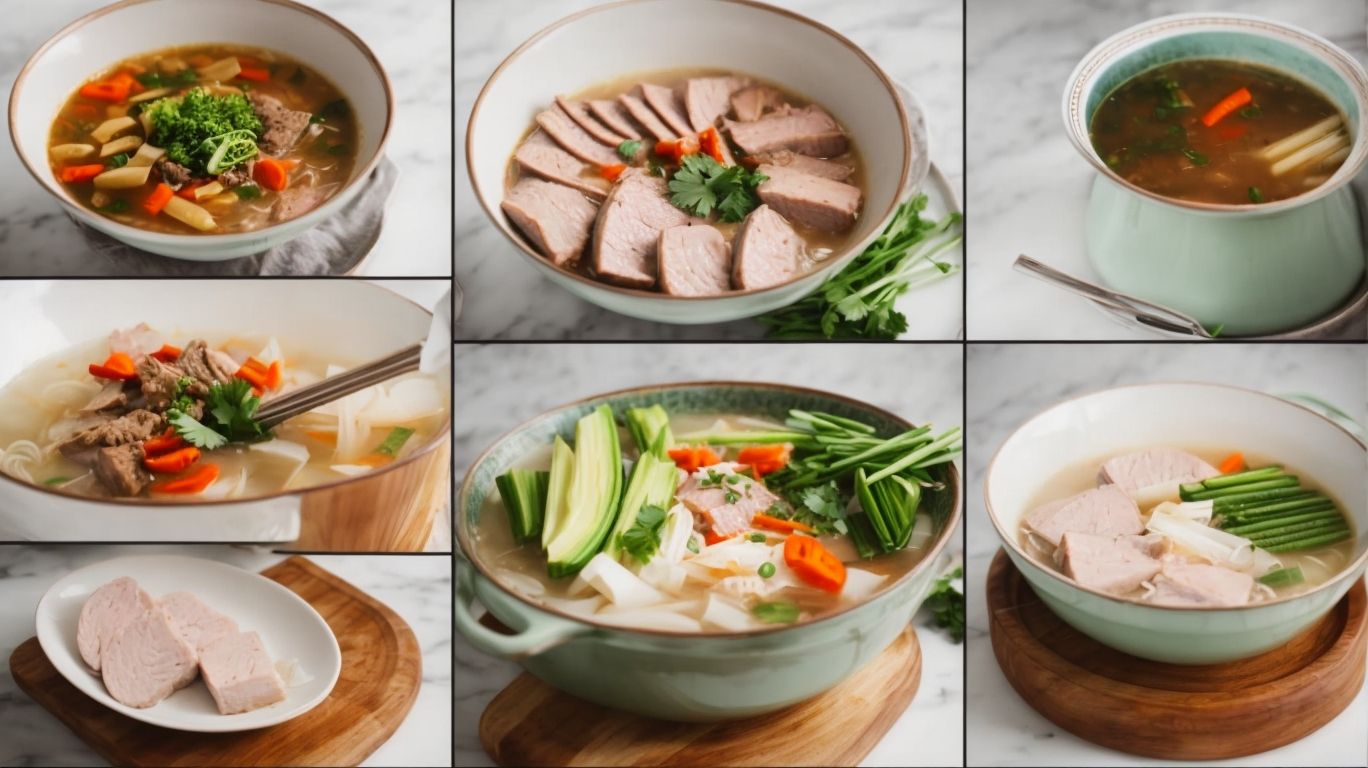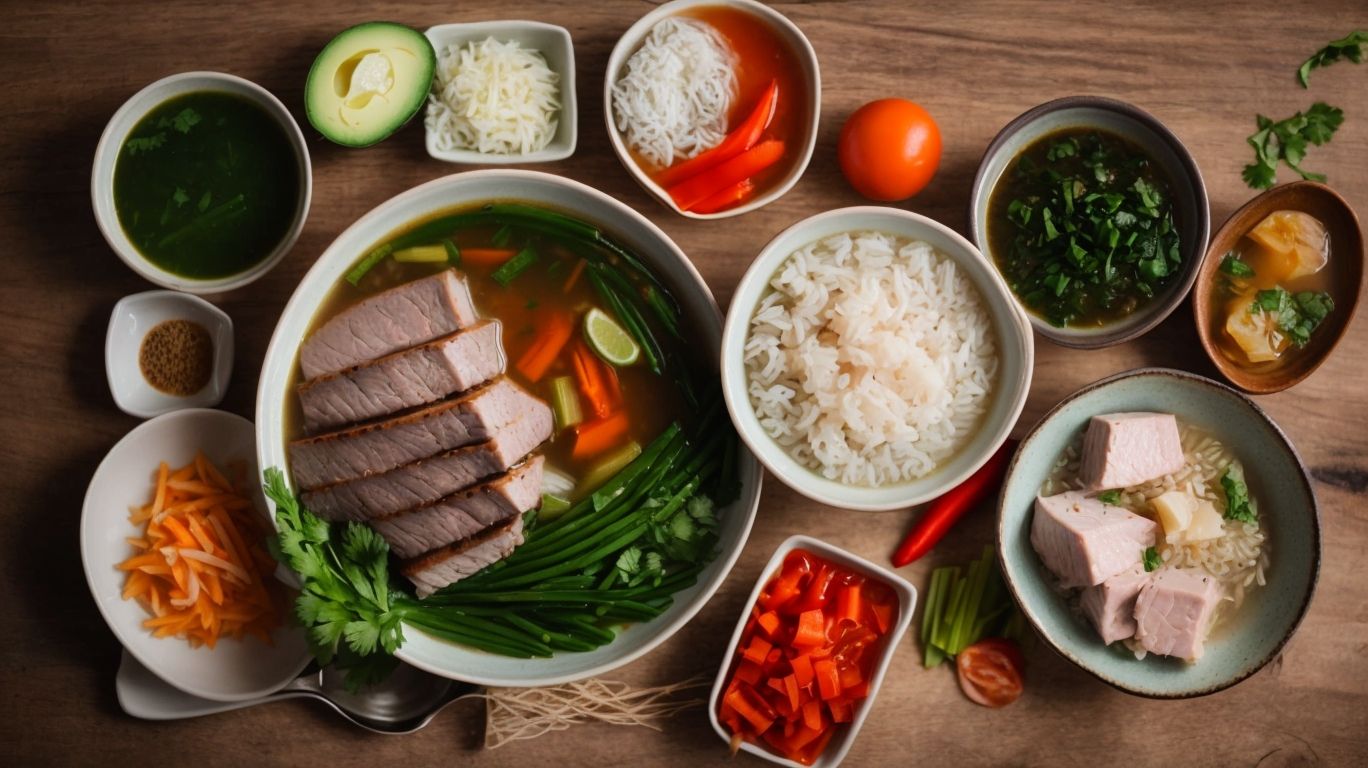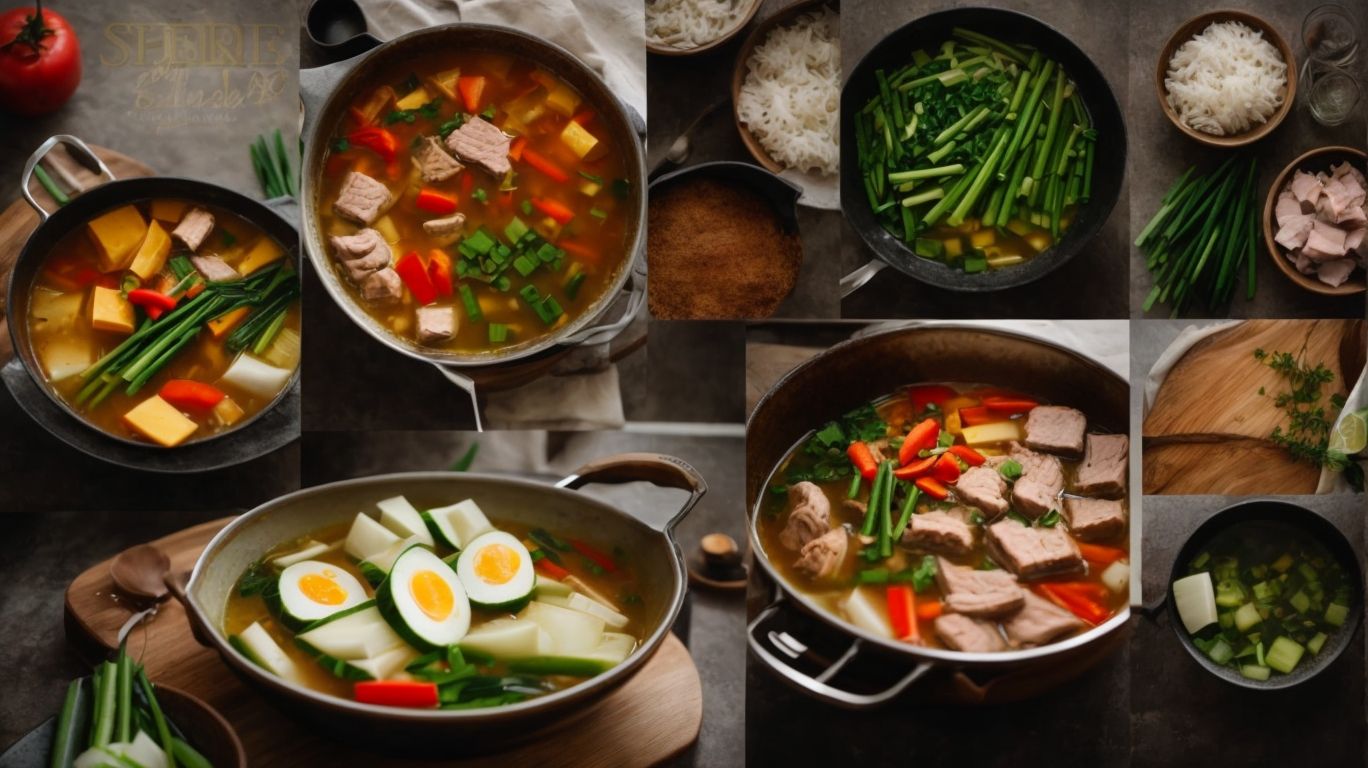How to Cook Sinigang Na Baboy Step by Step?
Sinigang Na Baboy is a classic Filipino dish known for its sour and savory flavors.
In this article, we will explore the history of Sinigang Na Baboy and take a closer look at the key ingredients that make up this delicious soup.
We will also provide you with a step-by-step guide on how to cook Sinigang Na Baboy at home, from preparing the meat to adding the vegetables and adjusting the taste.
Additionally, we will share tips on serving and presenting this dish, as well as variations you can try.
If you’re ready to learn how to make this traditional Filipino favorite, keep on reading!
Key Takeaways:
What is Sinigang Na Baboy?
Sinigang Na Baboy is a traditional Filipino sour soup that features pork as the main ingredient, cooked with a souring agent to give it a distinct and savory flavor.
This iconic dish holds significant cultural importance in Filipino cuisine, often being served at gatherings and special occasions as a comforting and communal meal.
Sinigang Na Baboy can be prepared in various regional variations, with each region adding its unique twist to the recipe, showcasing the diverse culinary landscape of the Philippines.
The sourness in Sinigang Na Baboy traditionally comes from ingredients like tamarind fruit, calamansi, guava, or green mango, but nowadays, many opt for convenience using sinigang mix for a quicker preparation.
History of Sinigang Na Baboy
Sinigang Na Baboy holds a special place in Filipino culinary heritage, often regarded as a national dish that reflects the rich flavors and traditional cooking techniques of the Philippines.
This iconic dish traces its origins back to pre-colonial times, where indigenous communities would concoct sour soups using tamarind and other local ingredients. Over the centuries, Sinigang Na Baboy has evolved and adapted to incorporate diverse influences, including Chinese, Spanish, and Malay culinary traditions, resulting in a unique blend of flavors that capture the essence of Filipino cooking.
Known for its comforting and tangy broth, tender pork ribs or belly, and a medley of vegetables like water spinach, okra, and eggplant, every spoonful of this dish reflects the vibrant and varied culinary landscape of the Philippines.
Ingredients for Sinigang Na Baboy
The key ingredients for Sinigang Na Baboy include succulent pork belly, tangy tamarind juice, fresh water spinach, and a blend of traditional sinigang ingredients that contribute to its unique and flavorful profile.
Meat
When preparing Sinigang Na Baboy, the choice of meat is crucial, with options ranging from succulent pork belly to flavorful pork ribs, ensuring a tender and rich meaty component in this classic Filipino dish.
Each cut of pork offers a distinct texture and flavor profile when cooked in Sinigang, with pork belly known for its delicate fattiness that melts in your mouth, while pork ribs contribute a hearty and meaty taste.
- To achieve the perfect balance of tenderness and flavor, marinading the meat in a mixture of tamarind paste, onions, and garlic before cooking can enhance the overall taste profile of the dish.
- Simmering the meat slowly in the sour tamarind broth, along with an array of vegetables like radish, eggplant, and spinach, allows the flavors to meld together harmoniously, resulting in a comforting and flavorful bowl of Sinigang.
Vegetables
The vegetable component of Sinigang Na Baboy offers a vibrant array of flavors and textures, with ingredients like tomatoes, onions, and okra contributing to the overall balance and nutritional value of this hearty soup.
Each vegetable plays a crucial role in elevating the dish; the tangy sweetness of ripe tomatoes harmonizes with the earthy pungency of onions, creating a rich base for the savory broth. Meanwhile, the slimy texture of okra not only thickens the soup but also imparts a unique mouthfeel that adds depth to every spoonful. To enhance the visual appeal, thinly sliced radish or water spinach can be added, offering a pop of color and freshness to the ensemble. Experimenting with different vegetables like eggplant or string beans can introduce delightful variations to the traditional recipe.
Flavorings and Seasonings
To infuse Sinigang Na Baboy with its signature tangy and savory notes, flavorings and seasonings such as sinigang mix, tamarind powder, and a medley of herbs and spices are skillfully combined to create a delectable and comforting soup.
These essential ingredients play a crucial role in giving this Filipino favorite its distinctive taste profile. The sinigang mix, typically a blend of tamarind, tomatoes, and aromatics, provides the base for the flavorful broth that forms the heart of the dish. Tamarind powder adds a tangy punch that cuts through the richness of the pork, creating a harmonious balance of flavors.
The careful selection of herbs and spices, like lemongrass, ginger, and peppercorns, elevates the complexity of the broth, infusing it with layers of aromatic goodness. The combination of these seasonings not only enhances the taste of the pork but also brings out the natural sweetness of the vegetables added to the soup, creating a well-rounded and satisfying culinary experience.
Step-by-Step Guide to Cooking Sinigang Na Baboy

Credits: Poormet.Com – Roger Davis
Mastering the art of cooking Sinigang Na Baboy involves a step-by-step process that includes preparing the meat, simmering the soup to perfection, and infusing it with a blend of vegetables and flavorings for a harmonious culinary experience.
Start by selecting the best pork cuts for the dish, typically pork belly or pork ribs, washing them thoroughly to remove excess blood and impurities.
Next, in a large pot, combine water, tamarind paste or Sinigang mix, onions, tomatoes, and the pork, allowing them to boil until the meat is tender. As the broth develops, add finger chilies to enhance the tangy flavor with a spicy kick.
Season with fish sauce and adjust the taste with a bit of salt and sugar, creating the perfect balance of sourness and savory notes.
Step 1: Preparing the Meat
The first crucial step in preparing Sinigang Na Baboy is meticulously handling the meat, ensuring it is cleaned, cut, and seasoned with essentials like fish sauce, gabi, and fresh tomatoes to lay the foundation for a flavorsome dish.
After the meat is properly seasoned, it is vital to let it marinate for at least an hour, allowing the flavors to meld together.
- In a large pot, heat some oil and sauté onions and garlic until fragrant.
- Carefully add the marinated meat, followed by water, and bring it to a simmer.
Once simmering, add in the key ingredient for Sinigang – the tamarind broth. This sour flavor is essential in balancing the richness of the pork. Throw in some fresh radish, string beans, and eggplant for a wholesome and nutritious touch.
Step 2: Boiling the Meat
Boiling the meat in a flavorful broth infused with a souring agent like green tamarind or sinigang mix is a crucial step in the Sinigang Na Baboy preparation process, ensuring that the pork spareribs are tender and imbued with savory undertones.
The souring agent not only enhances the overall sinigang flavor profile but also aids in tenderizing the meat, allowing it to absorb the rich essence of the broth. As the pork simmers in the fragrant broth, the sinigang mix or tamarind gradually imparts its tangy notes, balancing the sweetness of the pork cuts. The aromatic spices like black pepper play a key role in adding depth and warmth to the dish, elevating its taste to a harmonious blend of savory, sour, and subtly spicy notes.
Step 3: Adding the Vegetables
Incorporating a colorful assortment of vegetables like kangkong leaves, sinampalukang manok, bamboo shoot tips, and wild mangosteen into the simmering broth elevates the visual appeal and nutritional value of Sinigang Na Baboy, creating a wholesome and balanced dish.
Traditionally, Filipinos prefer using local greens such as labanos, okra, and eggplant, adding depth of flavor and texture to the sour soup. Regional variations across the Philippines showcase the diverse choices of vegetables used, with some areas opting for malunggay leaves or even water spinach to enhance the complexity of the broth.
The addition of tropical vegetables not only enriches the taste profile but also boosts the nutrient content, providing essential vitamins and minerals. This diversity of produce not only aligns with Filipino culinary heritage but also reflects the cultural significance of using fresh ingredients in cooking, promoting a healthier lifestyle.
Step 4: Flavoring and Seasoning
Balancing the flavors of Sinigang Na Baboy requires a careful selection and addition of seasonings like tamarind for acidity, salt and pepper for seasoning, and a variety of vegetables including bamboo shoots and bok choy to enhance the overall taste profile of the dish.
One of the key aspects of crafting the perfect Sinigang Na Baboy lies in the harmonious interplay between these distinct flavors and textures. The sourness from the tamarind not only adds a tangy kick but also acts as a natural tenderizer for the pork, ensuring a melt-in-your-mouth experience. While salt and pepper elevate the dish with their simple yet essential seasoning properties, the medley of vegetables brings a refreshing crunch and a burst of vibrant colors to each spoonful.
Step 5: Simmering and Adjusting the Taste
Simmering the Sinigang Na Baboy to perfection allows the flavors to meld together, creating a delightful medley of tastes and textures, while adjusting the seasoning with ingredients like finger chilies and long beans adds a personal touch to tailor the dish to individual preferences.
The final stages of cooking Sinigang Na Baboy involve the crucial process of simmering, where the broth intensifies, and the meat becomes tender, infused with the sourness from tamarind and the aromatic blend of spices.
During this phase, it’s essential to taste and adjust the flavors accordingly, whether you prefer a more tangy or savory profile, by incorporating additional ingredients such as radish, eggplant, or water spinach.
Serving and Presentation of Sinigang Na Baboy

Credits: Poormet.Com – Terry Martinez
Presenting and serving Sinigang Na Baboy is an artful process that involves arranging the soup and its accompaniments in an appealing manner, offering guests guidance on how to enjoy this beloved Filipino soup dish to the fullest.
One key aspect of serving Sinigang Na Baboy is selecting the right bowl. Traditionally, a wide-rimmed soup bowl or a deep plate is used to showcase the vibrant colors and generous portions of the dish. Placing a steaming bowl of sinigang on a table setting with a banana leaf underneath adds a touch of traditional flair.
Garnishing the sinigang can significantly elevate its presentation. Freshly chopped green onions, a squeeze of calamansi juice, and a few sprigs of fresh cilantro or parsley can add brightness and freshness to the dish.
How to Serve Sinigang Na Baboy
Serving Sinigang Na Baboy involves ladling the sour broth filled with chunks of pork belly, tamarind fruit, and a colorful array of vegetables into individual bowls, with a garnish of fresh bok choy adding a vibrant touch to the presentation.
Portioning out this traditional Filipino soup requires an artful balance of flavors and textures. Each bowl showcases the tender pieces of pork belly, stewed to perfection in the tangy tamarind-infused broth. The sour broth, with its distinct sourness from the tamarind, offers a refreshing contrast to the richness of the pork.
Garnishing with the bright green bok choy not only enhances the aesthetics but also adds a crispness that complements the soft meat and vegetables. The visual appeal of the colorful ingredients in each bowl is a feast for the eyes before even taking the first spoonful.
Tips for Presentation
To elevate the presentation of Sinigang Na Baboy, consider incorporating decorative elements, ensuring the meat is tender, and showcasing the vibrant colors of the vegetables to create an enticing visual display that complements the rich flavors of this iconic Filipino soup.
Plating plays a significant role in the overall appeal of Sinigang Na Baboy. Consider using traditional Filipino serving dishes or banana leaves for an authentic touch. Arrange the ingredients strategically to create a balanced and visually appealing composition. Balancing textures is crucial; ensure a mix of soft, crunchy, and chewy elements in each bowl. Garnish with fresh herbs like cilantro or parsley for a pop of color and freshness.
Variations of Sinigang Na Baboy
Exploring the diverse variations of Sinigang Na Baboy offers a culinary adventure, with options ranging from tangy pineapple-infused versions to traditional renditions that highlight the sour and savory interplay of flavors found in this beloved Filipino dish.
One fascinating adaptation of Sinigang Na Baboy is the Ilonggo Sinigang that features a unique blend of native sampaloc leaves and green tomatoes, adding a refreshing twist to the broth.
Another regional variation originates from the Bicol region, known for its Sinigang with gabi leaves, infusing a rich and creamy texture to the soup.
Some innovative chefs have experimented with seafood sinigang, incorporating prawns, mussels, and fish to create a seafood delight within the tangy broth.
Sinigang Na Baboy with Tamarind
Sinigang Na Baboy with Tamarind presents a delightful twist on the classic recipe, infusing the soup with the tangy sweetness of pineapples and the rich depth of sinigang mix to create a harmonious blend of flavors that tantalize the taste buds.
What sets this dish apart is the special simmering technique employed to achieve the perfect balance of sourness and savory notes. The use of fresh tamarind pulp or sinigang mix plays a crucial role in intensifying the tangy profile of the broth, while the inclusion of various vegetables like water spinach, radish, and eggplant enhances the overall texture and nutritional value of the dish.
Sinigang Na Baboy with Guava
Sinigang Na Baboy with Guava offers a tropical twist to the traditional recipe, infusing the sour soup with the exotic sweetness of guava and the earthy notes of taro, creating a unique and refreshing flavor profile that transports diners to the lush landscapes of the Philippines.
Guava, a tropical fruit known for its vibrant flavor and richness in Vitamin C, adds a delightful complexity to the sinigang broth, balancing the tangy tamarind base with its natural sweetness. Taro, a starchy root vegetable, brings a velvety texture to the dish, complementing the tender pork belly or ribs typically used in this Filipino soup.
The marriage of these diverse ingredients showcases the versatility of sinigang variations, where regional tweaks and personal preferences shine through. Some households opt for pineapple for a touch of acidity, while others experiment with green mango for an extra kick of sourness.
Sinigang Na Baboy with Pineapple
Sinigang Na Baboy with Pineapple pays homage to the traditional roots of this national dish, marrying the tangy sweetness of pineapple with the classic souring agents and aromatic bamboo shoots, creating a harmonious fusion of flavors that showcases the best of Filipino culinary heritage.
This delightful variation of Sinigang Na Baboy transcends boundaries and time, embodying the essence of Filipino creativity and adaptability in the culinary realm. The incorporation of Pineapple adds a refreshing twist to the robust flavors of the dish, balancing the savory notes with a subtle hint of fruity sweetness that elevates the overall dining experience. By infusing indigenous ingredients such as tamarind, tomatoes, and water spinach with this tropical fruit, chefs bring a modern twist to a beloved classic, satisfying both purists and adventurous food enthusiasts alike.
Frequently Asked Questions
1. What are the ingredients needed to cook Sinigang Na Baboy?
To make Sinigang Na Baboy, you will need pork belly, tamarind paste, vegetables such as kangkong, eggplant, and radish, and other seasonings like fish sauce and onion.
2. How do I properly prepare the pork for Sinigang Na Baboy?
Cut the pork belly into cubes and wash them thoroughly. Then, marinate the pork in a mixture of calamansi juice, salt, and pepper for at least 30 minutes to enhance the flavor.
3. What is the key ingredient for making Sinigang Na Baboy?
Tamarind paste or sampaloc is the essential ingredient for making Sinigang Na Baboy. It gives the dish its signature sour flavor.
4. Can I use other types of meat instead of pork for Sinigang?
Yes, you can use other types of meat such as beef, fish, or shrimp for Sinigang. However, the cooking time may vary depending on the meat you choose.
5. How do I know when the Sinigang Na Baboy is ready to serve?
You will know it is ready when the pork is tender, and the vegetables are cooked but still slightly firm. Taste the broth to check if it has the right balance of sourness and saltiness.
6. Can I freeze leftover Sinigang Na Baboy?
Yes, you can freeze leftover Sinigang Na Baboy in an airtight container for up to 3 months. Just reheat it in a pot over medium heat until heated through before serving.





